Annotated Bibliography: Key Theories of Employee Motivation
VerifiedAdded on 2020/10/23
|10
|3353
|447
Annotated Bibliography
AI Summary
This annotated bibliography examines seven articles focusing on motivational theories and their influence on employee performance. The articles discuss various frameworks, including Maslow's hierarchy of needs, Herzberg's two-factor theory, and McGregor's Theory X and Y, highlighting their application in different organizational contexts. The studies explore the impact of leadership styles, employee engagement, and compensation practices on motivation and productivity. The bibliography emphasizes the importance of creating a positive work environment, providing incentives, and fostering employee satisfaction to enhance commitment and achieve organizational goals. The research also touches upon public service motivation, self-determination theory, and the role of training and development in improving employee performance. The findings underscore the significance of understanding and addressing employee needs to boost productivity and retain skilled workers. The articles also touch upon the negative impacts of poor management, lack of incentives, and rigid policies on employee motivation and performance.
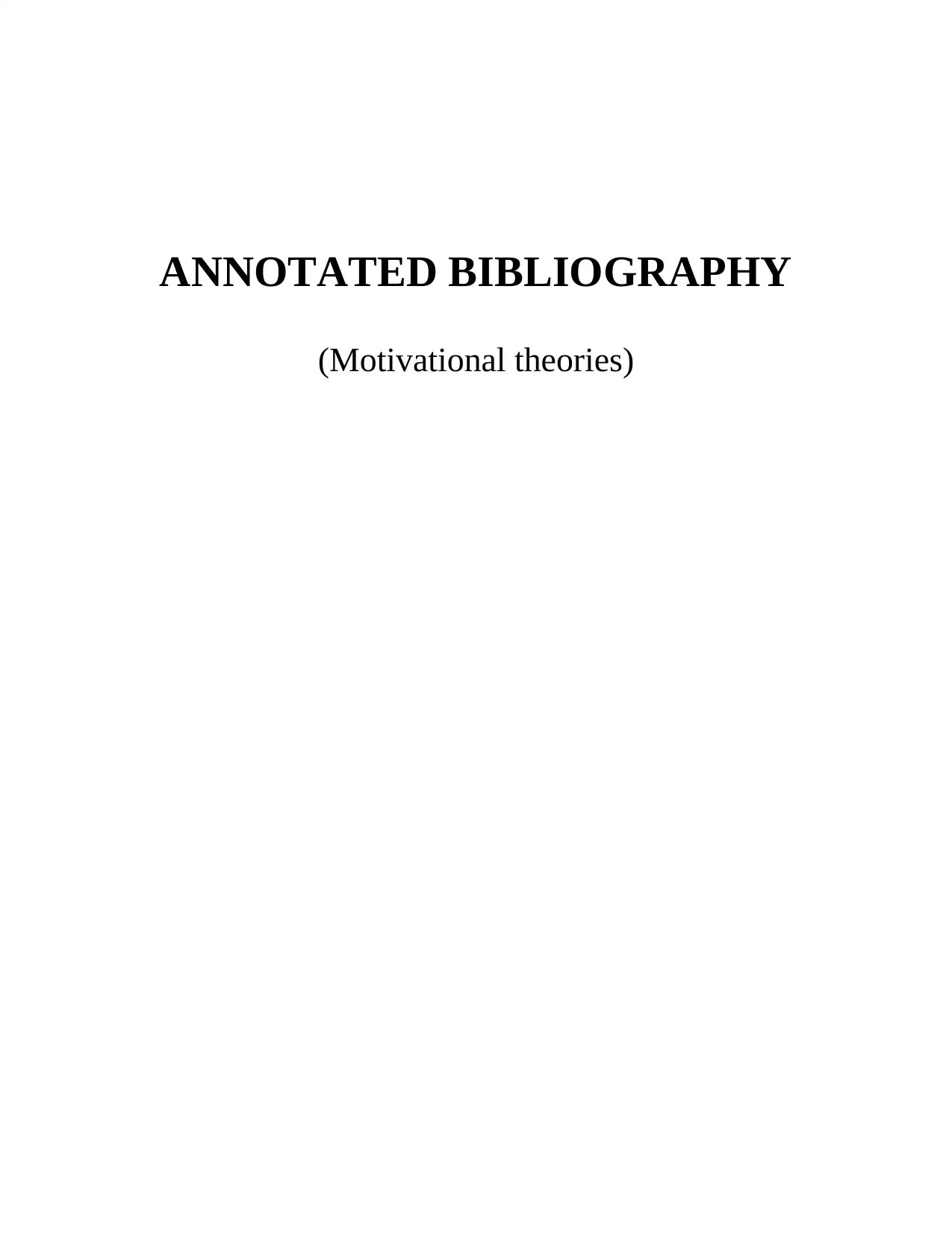
ANNOTATED BIBLIOGRAPHY
(Motivational theories)
(Motivational theories)
Paraphrase This Document
Need a fresh take? Get an instant paraphrase of this document with our AI Paraphraser
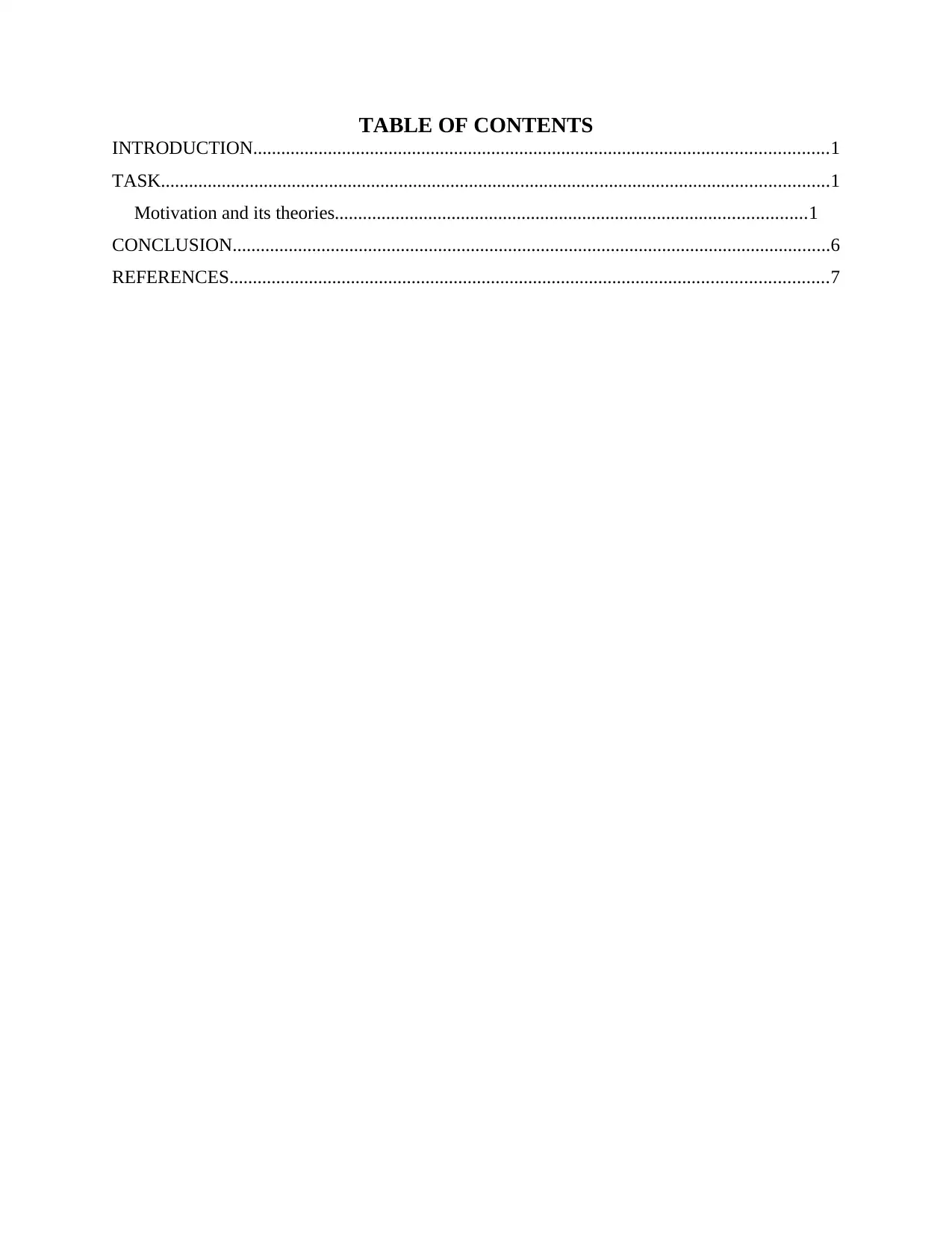
TABLE OF CONTENTS
INTRODUCTION...........................................................................................................................1
TASK...............................................................................................................................................1
Motivation and its theories.....................................................................................................1
CONCLUSION................................................................................................................................6
REFERENCES................................................................................................................................7
INTRODUCTION...........................................................................................................................1
TASK...............................................................................................................................................1
Motivation and its theories.....................................................................................................1
CONCLUSION................................................................................................................................6
REFERENCES................................................................................................................................7
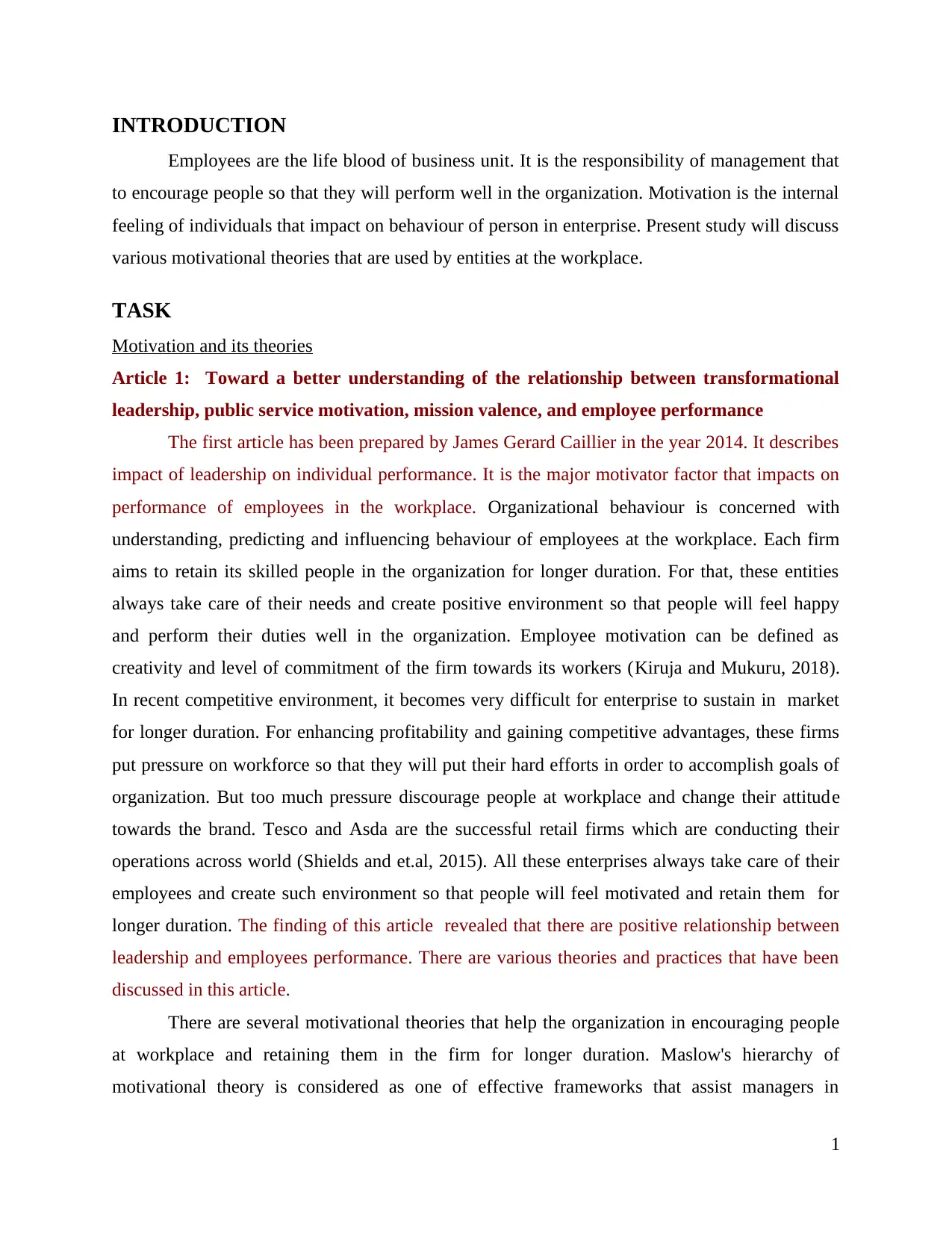
INTRODUCTION
Employees are the life blood of business unit. It is the responsibility of management that
to encourage people so that they will perform well in the organization. Motivation is the internal
feeling of individuals that impact on behaviour of person in enterprise. Present study will discuss
various motivational theories that are used by entities at the workplace.
TASK
Motivation and its theories
Article 1: Toward a better understanding of the relationship between transformational
leadership, public service motivation, mission valence, and employee performance
The first article has been prepared by James Gerard Caillier in the year 2014. It describes
impact of leadership on individual performance. It is the major motivator factor that impacts on
performance of employees in the workplace. Organizational behaviour is concerned with
understanding, predicting and influencing behaviour of employees at the workplace. Each firm
aims to retain its skilled people in the organization for longer duration. For that, these entities
always take care of their needs and create positive environment so that people will feel happy
and perform their duties well in the organization. Employee motivation can be defined as
creativity and level of commitment of the firm towards its workers (Kiruja and Mukuru, 2018).
In recent competitive environment, it becomes very difficult for enterprise to sustain in market
for longer duration. For enhancing profitability and gaining competitive advantages, these firms
put pressure on workforce so that they will put their hard efforts in order to accomplish goals of
organization. But too much pressure discourage people at workplace and change their attitude
towards the brand. Tesco and Asda are the successful retail firms which are conducting their
operations across world (Shields and et.al, 2015). All these enterprises always take care of their
employees and create such environment so that people will feel motivated and retain them for
longer duration. The finding of this article revealed that there are positive relationship between
leadership and employees performance. There are various theories and practices that have been
discussed in this article.
There are several motivational theories that help the organization in encouraging people
at workplace and retaining them in the firm for longer duration. Maslow's hierarchy of
motivational theory is considered as one of effective frameworks that assist managers in
1
Employees are the life blood of business unit. It is the responsibility of management that
to encourage people so that they will perform well in the organization. Motivation is the internal
feeling of individuals that impact on behaviour of person in enterprise. Present study will discuss
various motivational theories that are used by entities at the workplace.
TASK
Motivation and its theories
Article 1: Toward a better understanding of the relationship between transformational
leadership, public service motivation, mission valence, and employee performance
The first article has been prepared by James Gerard Caillier in the year 2014. It describes
impact of leadership on individual performance. It is the major motivator factor that impacts on
performance of employees in the workplace. Organizational behaviour is concerned with
understanding, predicting and influencing behaviour of employees at the workplace. Each firm
aims to retain its skilled people in the organization for longer duration. For that, these entities
always take care of their needs and create positive environment so that people will feel happy
and perform their duties well in the organization. Employee motivation can be defined as
creativity and level of commitment of the firm towards its workers (Kiruja and Mukuru, 2018).
In recent competitive environment, it becomes very difficult for enterprise to sustain in market
for longer duration. For enhancing profitability and gaining competitive advantages, these firms
put pressure on workforce so that they will put their hard efforts in order to accomplish goals of
organization. But too much pressure discourage people at workplace and change their attitude
towards the brand. Tesco and Asda are the successful retail firms which are conducting their
operations across world (Shields and et.al, 2015). All these enterprises always take care of their
employees and create such environment so that people will feel motivated and retain them for
longer duration. The finding of this article revealed that there are positive relationship between
leadership and employees performance. There are various theories and practices that have been
discussed in this article.
There are several motivational theories that help the organization in encouraging people
at workplace and retaining them in the firm for longer duration. Maslow's hierarchy of
motivational theory is considered as one of effective frameworks that assist managers in
1
⊘ This is a preview!⊘
Do you want full access?
Subscribe today to unlock all pages.

Trusted by 1+ million students worldwide
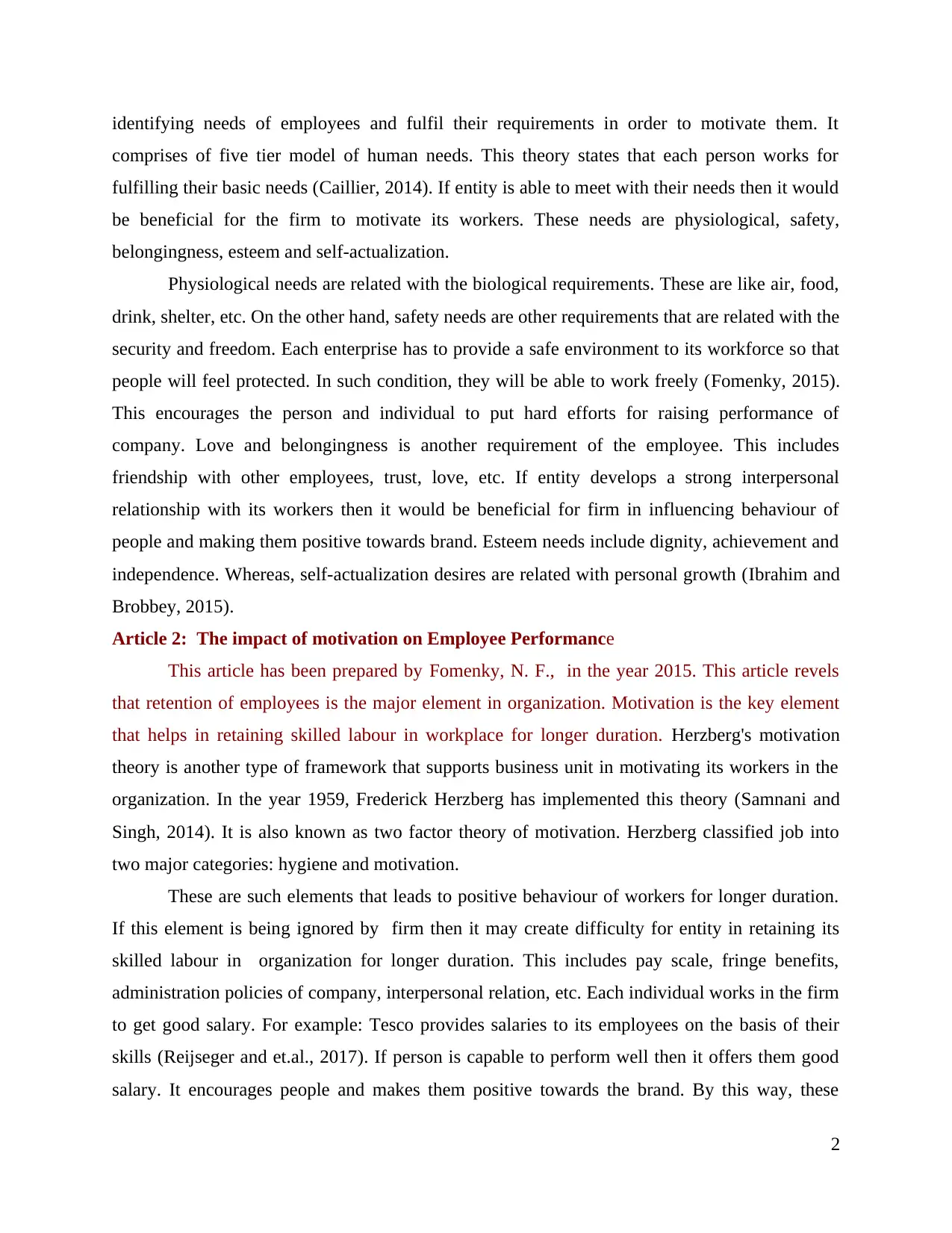
identifying needs of employees and fulfil their requirements in order to motivate them. It
comprises of five tier model of human needs. This theory states that each person works for
fulfilling their basic needs (Caillier, 2014). If entity is able to meet with their needs then it would
be beneficial for the firm to motivate its workers. These needs are physiological, safety,
belongingness, esteem and self-actualization.
Physiological needs are related with the biological requirements. These are like air, food,
drink, shelter, etc. On the other hand, safety needs are other requirements that are related with the
security and freedom. Each enterprise has to provide a safe environment to its workforce so that
people will feel protected. In such condition, they will be able to work freely (Fomenky, 2015).
This encourages the person and individual to put hard efforts for raising performance of
company. Love and belongingness is another requirement of the employee. This includes
friendship with other employees, trust, love, etc. If entity develops a strong interpersonal
relationship with its workers then it would be beneficial for firm in influencing behaviour of
people and making them positive towards brand. Esteem needs include dignity, achievement and
independence. Whereas, self-actualization desires are related with personal growth (Ibrahim and
Brobbey, 2015).
Article 2: The impact of motivation on Employee Performance
This article has been prepared by Fomenky, N. F., in the year 2015. This article revels
that retention of employees is the major element in organization. Motivation is the key element
that helps in retaining skilled labour in workplace for longer duration. Herzberg's motivation
theory is another type of framework that supports business unit in motivating its workers in the
organization. In the year 1959, Frederick Herzberg has implemented this theory (Samnani and
Singh, 2014). It is also known as two factor theory of motivation. Herzberg classified job into
two major categories: hygiene and motivation.
These are such elements that leads to positive behaviour of workers for longer duration.
If this element is being ignored by firm then it may create difficulty for entity in retaining its
skilled labour in organization for longer duration. This includes pay scale, fringe benefits,
administration policies of company, interpersonal relation, etc. Each individual works in the firm
to get good salary. For example: Tesco provides salaries to its employees on the basis of their
skills (Reijseger and et.al., 2017). If person is capable to perform well then it offers them good
salary. It encourages people and makes them positive towards the brand. By this way, these
2
comprises of five tier model of human needs. This theory states that each person works for
fulfilling their basic needs (Caillier, 2014). If entity is able to meet with their needs then it would
be beneficial for the firm to motivate its workers. These needs are physiological, safety,
belongingness, esteem and self-actualization.
Physiological needs are related with the biological requirements. These are like air, food,
drink, shelter, etc. On the other hand, safety needs are other requirements that are related with the
security and freedom. Each enterprise has to provide a safe environment to its workforce so that
people will feel protected. In such condition, they will be able to work freely (Fomenky, 2015).
This encourages the person and individual to put hard efforts for raising performance of
company. Love and belongingness is another requirement of the employee. This includes
friendship with other employees, trust, love, etc. If entity develops a strong interpersonal
relationship with its workers then it would be beneficial for firm in influencing behaviour of
people and making them positive towards brand. Esteem needs include dignity, achievement and
independence. Whereas, self-actualization desires are related with personal growth (Ibrahim and
Brobbey, 2015).
Article 2: The impact of motivation on Employee Performance
This article has been prepared by Fomenky, N. F., in the year 2015. This article revels
that retention of employees is the major element in organization. Motivation is the key element
that helps in retaining skilled labour in workplace for longer duration. Herzberg's motivation
theory is another type of framework that supports business unit in motivating its workers in the
organization. In the year 1959, Frederick Herzberg has implemented this theory (Samnani and
Singh, 2014). It is also known as two factor theory of motivation. Herzberg classified job into
two major categories: hygiene and motivation.
These are such elements that leads to positive behaviour of workers for longer duration.
If this element is being ignored by firm then it may create difficulty for entity in retaining its
skilled labour in organization for longer duration. This includes pay scale, fringe benefits,
administration policies of company, interpersonal relation, etc. Each individual works in the firm
to get good salary. For example: Tesco provides salaries to its employees on the basis of their
skills (Reijseger and et.al., 2017). If person is capable to perform well then it offers them good
salary. It encourages people and makes them positive towards the brand. By this way, these
2
Paraphrase This Document
Need a fresh take? Get an instant paraphrase of this document with our AI Paraphraser
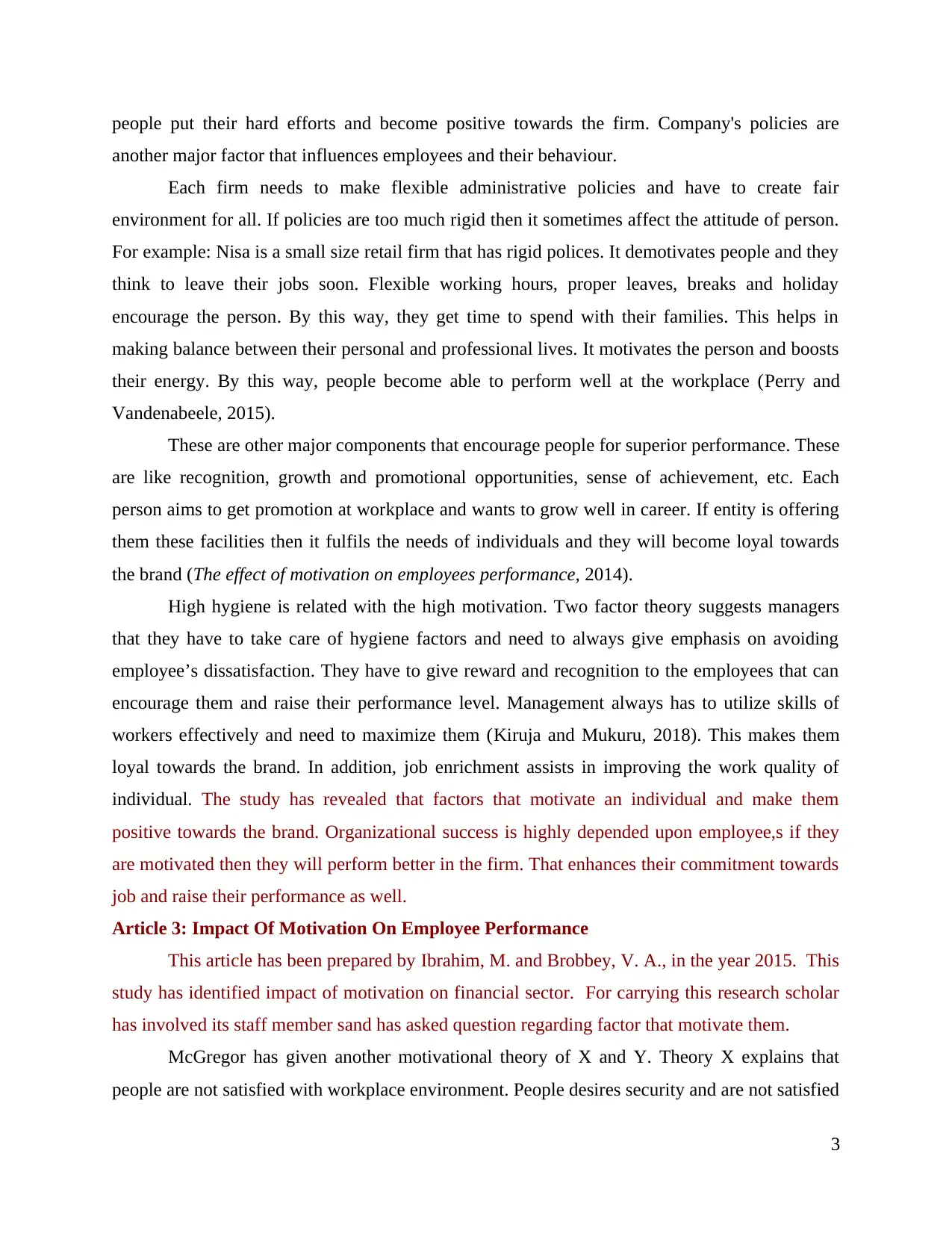
people put their hard efforts and become positive towards the firm. Company's policies are
another major factor that influences employees and their behaviour.
Each firm needs to make flexible administrative policies and have to create fair
environment for all. If policies are too much rigid then it sometimes affect the attitude of person.
For example: Nisa is a small size retail firm that has rigid polices. It demotivates people and they
think to leave their jobs soon. Flexible working hours, proper leaves, breaks and holiday
encourage the person. By this way, they get time to spend with their families. This helps in
making balance between their personal and professional lives. It motivates the person and boosts
their energy. By this way, people become able to perform well at the workplace (Perry and
Vandenabeele, 2015).
These are other major components that encourage people for superior performance. These
are like recognition, growth and promotional opportunities, sense of achievement, etc. Each
person aims to get promotion at workplace and wants to grow well in career. If entity is offering
them these facilities then it fulfils the needs of individuals and they will become loyal towards
the brand (The effect of motivation on employees performance, 2014).
High hygiene is related with the high motivation. Two factor theory suggests managers
that they have to take care of hygiene factors and need to always give emphasis on avoiding
employee’s dissatisfaction. They have to give reward and recognition to the employees that can
encourage them and raise their performance level. Management always has to utilize skills of
workers effectively and need to maximize them (Kiruja and Mukuru, 2018). This makes them
loyal towards the brand. In addition, job enrichment assists in improving the work quality of
individual. The study has revealed that factors that motivate an individual and make them
positive towards the brand. Organizational success is highly depended upon employee,s if they
are motivated then they will perform better in the firm. That enhances their commitment towards
job and raise their performance as well.
Article 3: Impact Of Motivation On Employee Performance
This article has been prepared by Ibrahim, M. and Brobbey, V. A., in the year 2015. This
study has identified impact of motivation on financial sector. For carrying this research scholar
has involved its staff member sand has asked question regarding factor that motivate them.
McGregor has given another motivational theory of X and Y. Theory X explains that
people are not satisfied with workplace environment. People desires security and are not satisfied
3
another major factor that influences employees and their behaviour.
Each firm needs to make flexible administrative policies and have to create fair
environment for all. If policies are too much rigid then it sometimes affect the attitude of person.
For example: Nisa is a small size retail firm that has rigid polices. It demotivates people and they
think to leave their jobs soon. Flexible working hours, proper leaves, breaks and holiday
encourage the person. By this way, they get time to spend with their families. This helps in
making balance between their personal and professional lives. It motivates the person and boosts
their energy. By this way, people become able to perform well at the workplace (Perry and
Vandenabeele, 2015).
These are other major components that encourage people for superior performance. These
are like recognition, growth and promotional opportunities, sense of achievement, etc. Each
person aims to get promotion at workplace and wants to grow well in career. If entity is offering
them these facilities then it fulfils the needs of individuals and they will become loyal towards
the brand (The effect of motivation on employees performance, 2014).
High hygiene is related with the high motivation. Two factor theory suggests managers
that they have to take care of hygiene factors and need to always give emphasis on avoiding
employee’s dissatisfaction. They have to give reward and recognition to the employees that can
encourage them and raise their performance level. Management always has to utilize skills of
workers effectively and need to maximize them (Kiruja and Mukuru, 2018). This makes them
loyal towards the brand. In addition, job enrichment assists in improving the work quality of
individual. The study has revealed that factors that motivate an individual and make them
positive towards the brand. Organizational success is highly depended upon employee,s if they
are motivated then they will perform better in the firm. That enhances their commitment towards
job and raise their performance as well.
Article 3: Impact Of Motivation On Employee Performance
This article has been prepared by Ibrahim, M. and Brobbey, V. A., in the year 2015. This
study has identified impact of motivation on financial sector. For carrying this research scholar
has involved its staff member sand has asked question regarding factor that motivate them.
McGregor has given another motivational theory of X and Y. Theory X explains that
people are not satisfied with workplace environment. People desires security and are not satisfied
3
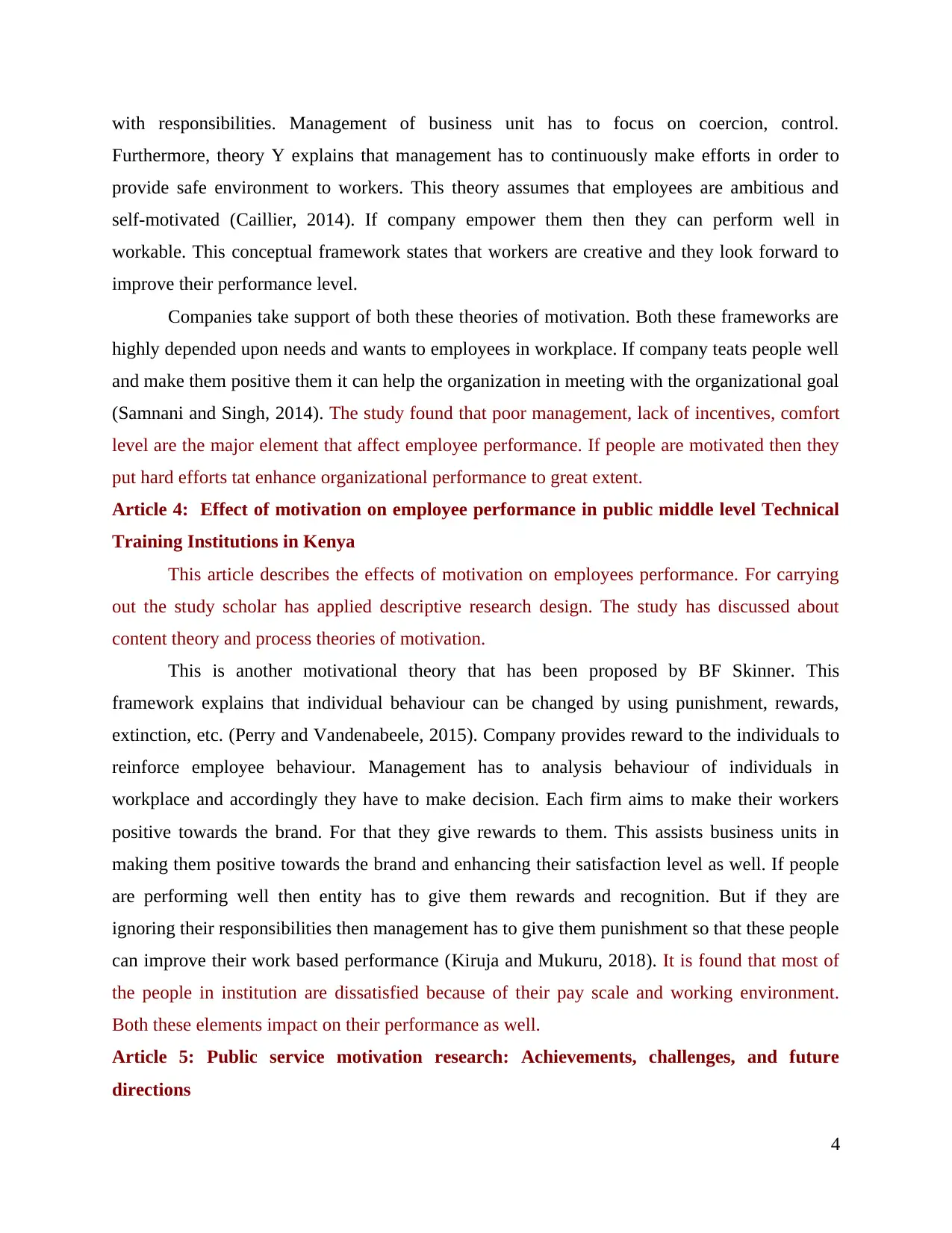
with responsibilities. Management of business unit has to focus on coercion, control.
Furthermore, theory Y explains that management has to continuously make efforts in order to
provide safe environment to workers. This theory assumes that employees are ambitious and
self-motivated (Caillier, 2014). If company empower them then they can perform well in
workable. This conceptual framework states that workers are creative and they look forward to
improve their performance level.
Companies take support of both these theories of motivation. Both these frameworks are
highly depended upon needs and wants to employees in workplace. If company teats people well
and make them positive them it can help the organization in meeting with the organizational goal
(Samnani and Singh, 2014). The study found that poor management, lack of incentives, comfort
level are the major element that affect employee performance. If people are motivated then they
put hard efforts tat enhance organizational performance to great extent.
Article 4: Effect of motivation on employee performance in public middle level Technical
Training Institutions in Kenya
This article describes the effects of motivation on employees performance. For carrying
out the study scholar has applied descriptive research design. The study has discussed about
content theory and process theories of motivation.
This is another motivational theory that has been proposed by BF Skinner. This
framework explains that individual behaviour can be changed by using punishment, rewards,
extinction, etc. (Perry and Vandenabeele, 2015). Company provides reward to the individuals to
reinforce employee behaviour. Management has to analysis behaviour of individuals in
workplace and accordingly they have to make decision. Each firm aims to make their workers
positive towards the brand. For that they give rewards to them. This assists business units in
making them positive towards the brand and enhancing their satisfaction level as well. If people
are performing well then entity has to give them rewards and recognition. But if they are
ignoring their responsibilities then management has to give them punishment so that these people
can improve their work based performance (Kiruja and Mukuru, 2018). It is found that most of
the people in institution are dissatisfied because of their pay scale and working environment.
Both these elements impact on their performance as well.
Article 5: Public service motivation research: Achievements, challenges, and future
directions
4
Furthermore, theory Y explains that management has to continuously make efforts in order to
provide safe environment to workers. This theory assumes that employees are ambitious and
self-motivated (Caillier, 2014). If company empower them then they can perform well in
workable. This conceptual framework states that workers are creative and they look forward to
improve their performance level.
Companies take support of both these theories of motivation. Both these frameworks are
highly depended upon needs and wants to employees in workplace. If company teats people well
and make them positive them it can help the organization in meeting with the organizational goal
(Samnani and Singh, 2014). The study found that poor management, lack of incentives, comfort
level are the major element that affect employee performance. If people are motivated then they
put hard efforts tat enhance organizational performance to great extent.
Article 4: Effect of motivation on employee performance in public middle level Technical
Training Institutions in Kenya
This article describes the effects of motivation on employees performance. For carrying
out the study scholar has applied descriptive research design. The study has discussed about
content theory and process theories of motivation.
This is another motivational theory that has been proposed by BF Skinner. This
framework explains that individual behaviour can be changed by using punishment, rewards,
extinction, etc. (Perry and Vandenabeele, 2015). Company provides reward to the individuals to
reinforce employee behaviour. Management has to analysis behaviour of individuals in
workplace and accordingly they have to make decision. Each firm aims to make their workers
positive towards the brand. For that they give rewards to them. This assists business units in
making them positive towards the brand and enhancing their satisfaction level as well. If people
are performing well then entity has to give them rewards and recognition. But if they are
ignoring their responsibilities then management has to give them punishment so that these people
can improve their work based performance (Kiruja and Mukuru, 2018). It is found that most of
the people in institution are dissatisfied because of their pay scale and working environment.
Both these elements impact on their performance as well.
Article 5: Public service motivation research: Achievements, challenges, and future
directions
4
⊘ This is a preview!⊘
Do you want full access?
Subscribe today to unlock all pages.

Trusted by 1+ million students worldwide
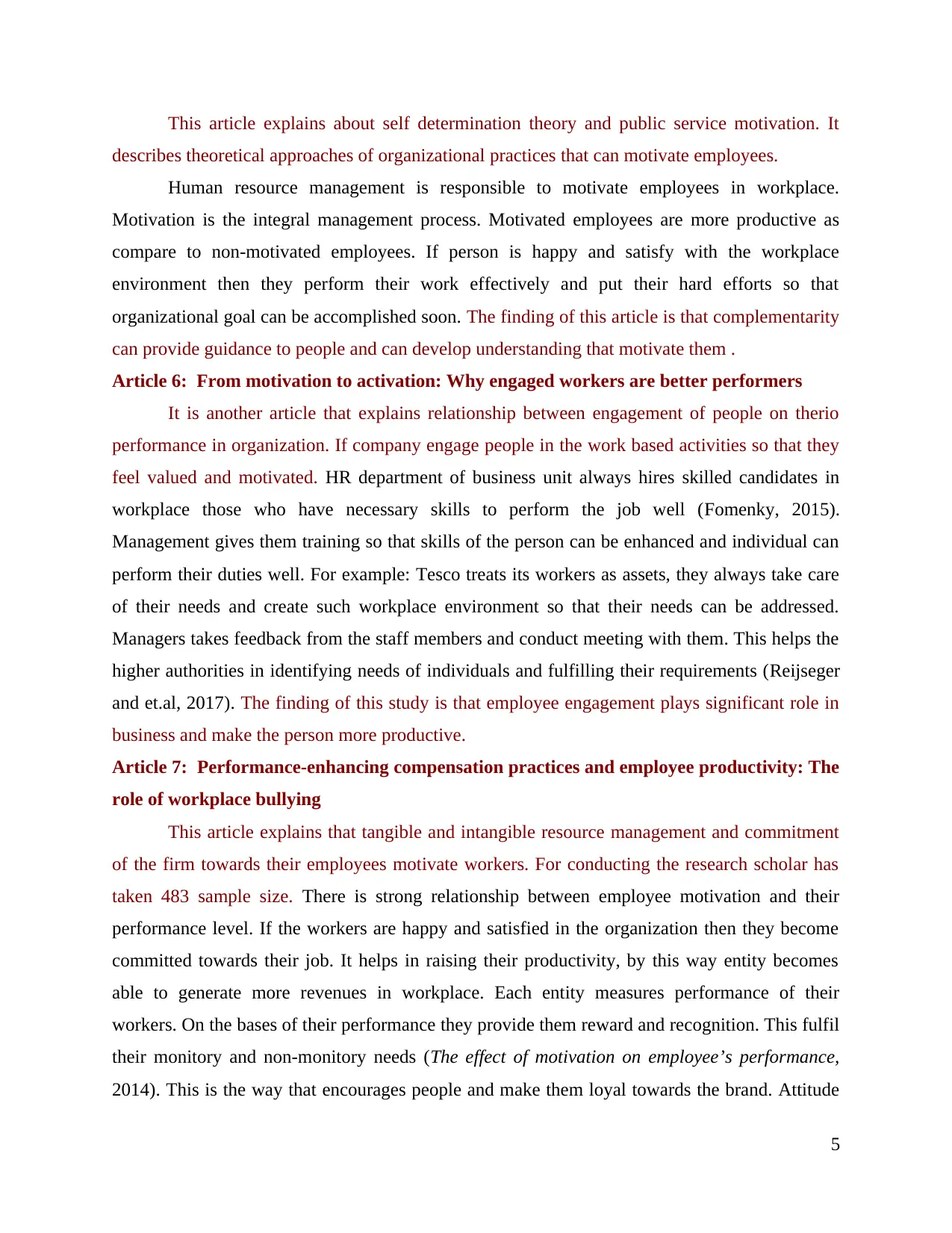
This article explains about self determination theory and public service motivation. It
describes theoretical approaches of organizational practices that can motivate employees.
Human resource management is responsible to motivate employees in workplace.
Motivation is the integral management process. Motivated employees are more productive as
compare to non-motivated employees. If person is happy and satisfy with the workplace
environment then they perform their work effectively and put their hard efforts so that
organizational goal can be accomplished soon. The finding of this article is that complementarity
can provide guidance to people and can develop understanding that motivate them .
Article 6: From motivation to activation: Why engaged workers are better performers
It is another article that explains relationship between engagement of people on therio
performance in organization. If company engage people in the work based activities so that they
feel valued and motivated. HR department of business unit always hires skilled candidates in
workplace those who have necessary skills to perform the job well (Fomenky, 2015).
Management gives them training so that skills of the person can be enhanced and individual can
perform their duties well. For example: Tesco treats its workers as assets, they always take care
of their needs and create such workplace environment so that their needs can be addressed.
Managers takes feedback from the staff members and conduct meeting with them. This helps the
higher authorities in identifying needs of individuals and fulfilling their requirements (Reijseger
and et.al, 2017). The finding of this study is that employee engagement plays significant role in
business and make the person more productive.
Article 7: Performance-enhancing compensation practices and employee productivity: The
role of workplace bullying
This article explains that tangible and intangible resource management and commitment
of the firm towards their employees motivate workers. For conducting the research scholar has
taken 483 sample size. There is strong relationship between employee motivation and their
performance level. If the workers are happy and satisfied in the organization then they become
committed towards their job. It helps in raising their productivity, by this way entity becomes
able to generate more revenues in workplace. Each entity measures performance of their
workers. On the bases of their performance they provide them reward and recognition. This fulfil
their monitory and non-monitory needs (The effect of motivation on employee’s performance,
2014). This is the way that encourages people and make them loyal towards the brand. Attitude
5
describes theoretical approaches of organizational practices that can motivate employees.
Human resource management is responsible to motivate employees in workplace.
Motivation is the integral management process. Motivated employees are more productive as
compare to non-motivated employees. If person is happy and satisfy with the workplace
environment then they perform their work effectively and put their hard efforts so that
organizational goal can be accomplished soon. The finding of this article is that complementarity
can provide guidance to people and can develop understanding that motivate them .
Article 6: From motivation to activation: Why engaged workers are better performers
It is another article that explains relationship between engagement of people on therio
performance in organization. If company engage people in the work based activities so that they
feel valued and motivated. HR department of business unit always hires skilled candidates in
workplace those who have necessary skills to perform the job well (Fomenky, 2015).
Management gives them training so that skills of the person can be enhanced and individual can
perform their duties well. For example: Tesco treats its workers as assets, they always take care
of their needs and create such workplace environment so that their needs can be addressed.
Managers takes feedback from the staff members and conduct meeting with them. This helps the
higher authorities in identifying needs of individuals and fulfilling their requirements (Reijseger
and et.al, 2017). The finding of this study is that employee engagement plays significant role in
business and make the person more productive.
Article 7: Performance-enhancing compensation practices and employee productivity: The
role of workplace bullying
This article explains that tangible and intangible resource management and commitment
of the firm towards their employees motivate workers. For conducting the research scholar has
taken 483 sample size. There is strong relationship between employee motivation and their
performance level. If the workers are happy and satisfied in the organization then they become
committed towards their job. It helps in raising their productivity, by this way entity becomes
able to generate more revenues in workplace. Each entity measures performance of their
workers. On the bases of their performance they provide them reward and recognition. This fulfil
their monitory and non-monitory needs (The effect of motivation on employee’s performance,
2014). This is the way that encourages people and make them loyal towards the brand. Attitude
5
Paraphrase This Document
Need a fresh take? Get an instant paraphrase of this document with our AI Paraphraser
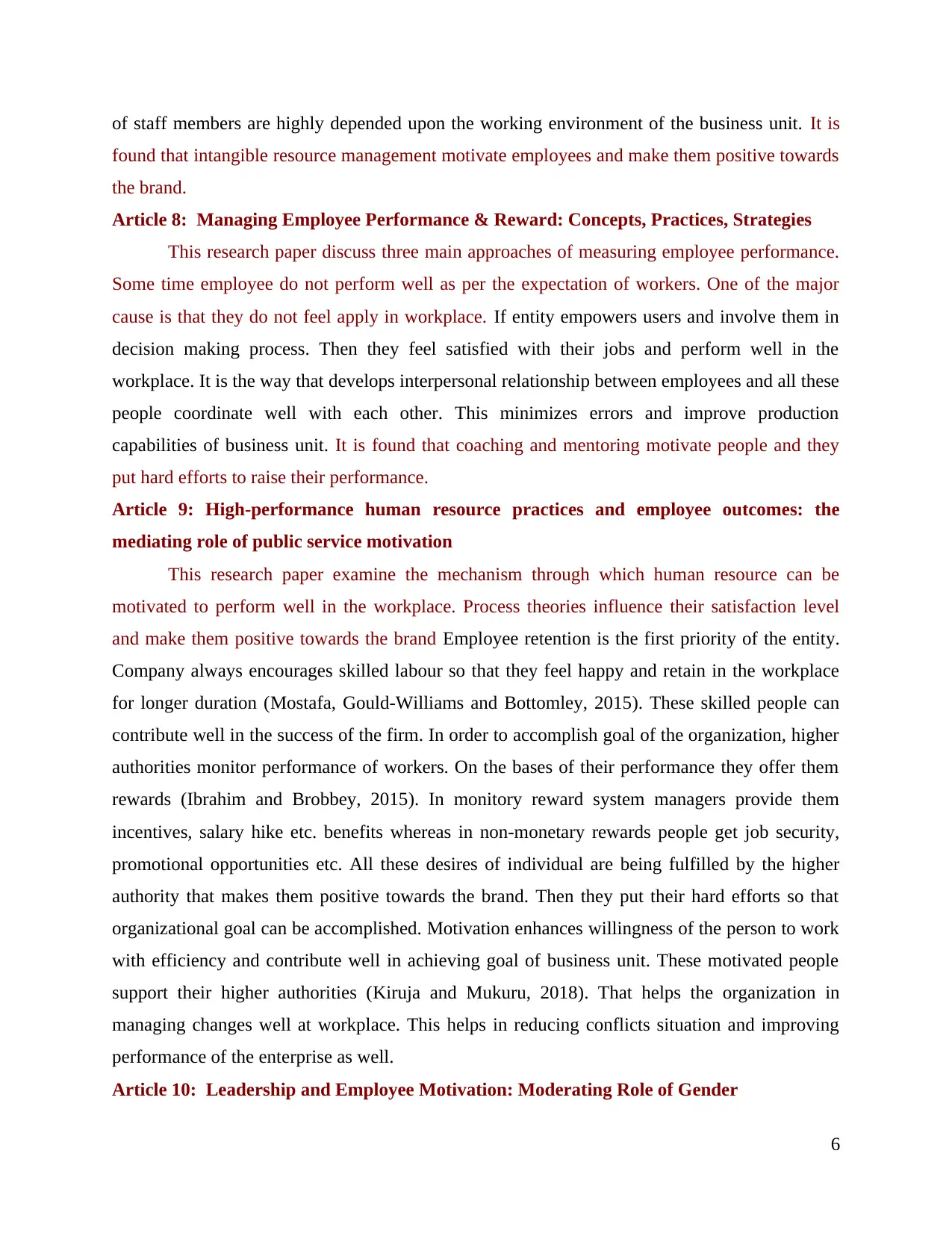
of staff members are highly depended upon the working environment of the business unit. It is
found that intangible resource management motivate employees and make them positive towards
the brand.
Article 8: Managing Employee Performance & Reward: Concepts, Practices, Strategies
This research paper discuss three main approaches of measuring employee performance.
Some time employee do not perform well as per the expectation of workers. One of the major
cause is that they do not feel apply in workplace. If entity empowers users and involve them in
decision making process. Then they feel satisfied with their jobs and perform well in the
workplace. It is the way that develops interpersonal relationship between employees and all these
people coordinate well with each other. This minimizes errors and improve production
capabilities of business unit. It is found that coaching and mentoring motivate people and they
put hard efforts to raise their performance.
Article 9: High‐performance human resource practices and employee outcomes: the
mediating role of public service motivation
This research paper examine the mechanism through which human resource can be
motivated to perform well in the workplace. Process theories influence their satisfaction level
and make them positive towards the brand Employee retention is the first priority of the entity.
Company always encourages skilled labour so that they feel happy and retain in the workplace
for longer duration (Mostafa, Gould‐Williams and Bottomley, 2015). These skilled people can
contribute well in the success of the firm. In order to accomplish goal of the organization, higher
authorities monitor performance of workers. On the bases of their performance they offer them
rewards (Ibrahim and Brobbey, 2015). In monitory reward system managers provide them
incentives, salary hike etc. benefits whereas in non-monetary rewards people get job security,
promotional opportunities etc. All these desires of individual are being fulfilled by the higher
authority that makes them positive towards the brand. Then they put their hard efforts so that
organizational goal can be accomplished. Motivation enhances willingness of the person to work
with efficiency and contribute well in achieving goal of business unit. These motivated people
support their higher authorities (Kiruja and Mukuru, 2018). That helps the organization in
managing changes well at workplace. This helps in reducing conflicts situation and improving
performance of the enterprise as well.
Article 10: Leadership and Employee Motivation: Moderating Role of Gender
6
found that intangible resource management motivate employees and make them positive towards
the brand.
Article 8: Managing Employee Performance & Reward: Concepts, Practices, Strategies
This research paper discuss three main approaches of measuring employee performance.
Some time employee do not perform well as per the expectation of workers. One of the major
cause is that they do not feel apply in workplace. If entity empowers users and involve them in
decision making process. Then they feel satisfied with their jobs and perform well in the
workplace. It is the way that develops interpersonal relationship between employees and all these
people coordinate well with each other. This minimizes errors and improve production
capabilities of business unit. It is found that coaching and mentoring motivate people and they
put hard efforts to raise their performance.
Article 9: High‐performance human resource practices and employee outcomes: the
mediating role of public service motivation
This research paper examine the mechanism through which human resource can be
motivated to perform well in the workplace. Process theories influence their satisfaction level
and make them positive towards the brand Employee retention is the first priority of the entity.
Company always encourages skilled labour so that they feel happy and retain in the workplace
for longer duration (Mostafa, Gould‐Williams and Bottomley, 2015). These skilled people can
contribute well in the success of the firm. In order to accomplish goal of the organization, higher
authorities monitor performance of workers. On the bases of their performance they offer them
rewards (Ibrahim and Brobbey, 2015). In monitory reward system managers provide them
incentives, salary hike etc. benefits whereas in non-monetary rewards people get job security,
promotional opportunities etc. All these desires of individual are being fulfilled by the higher
authority that makes them positive towards the brand. Then they put their hard efforts so that
organizational goal can be accomplished. Motivation enhances willingness of the person to work
with efficiency and contribute well in achieving goal of business unit. These motivated people
support their higher authorities (Kiruja and Mukuru, 2018). That helps the organization in
managing changes well at workplace. This helps in reducing conflicts situation and improving
performance of the enterprise as well.
Article 10: Leadership and Employee Motivation: Moderating Role of Gender
6
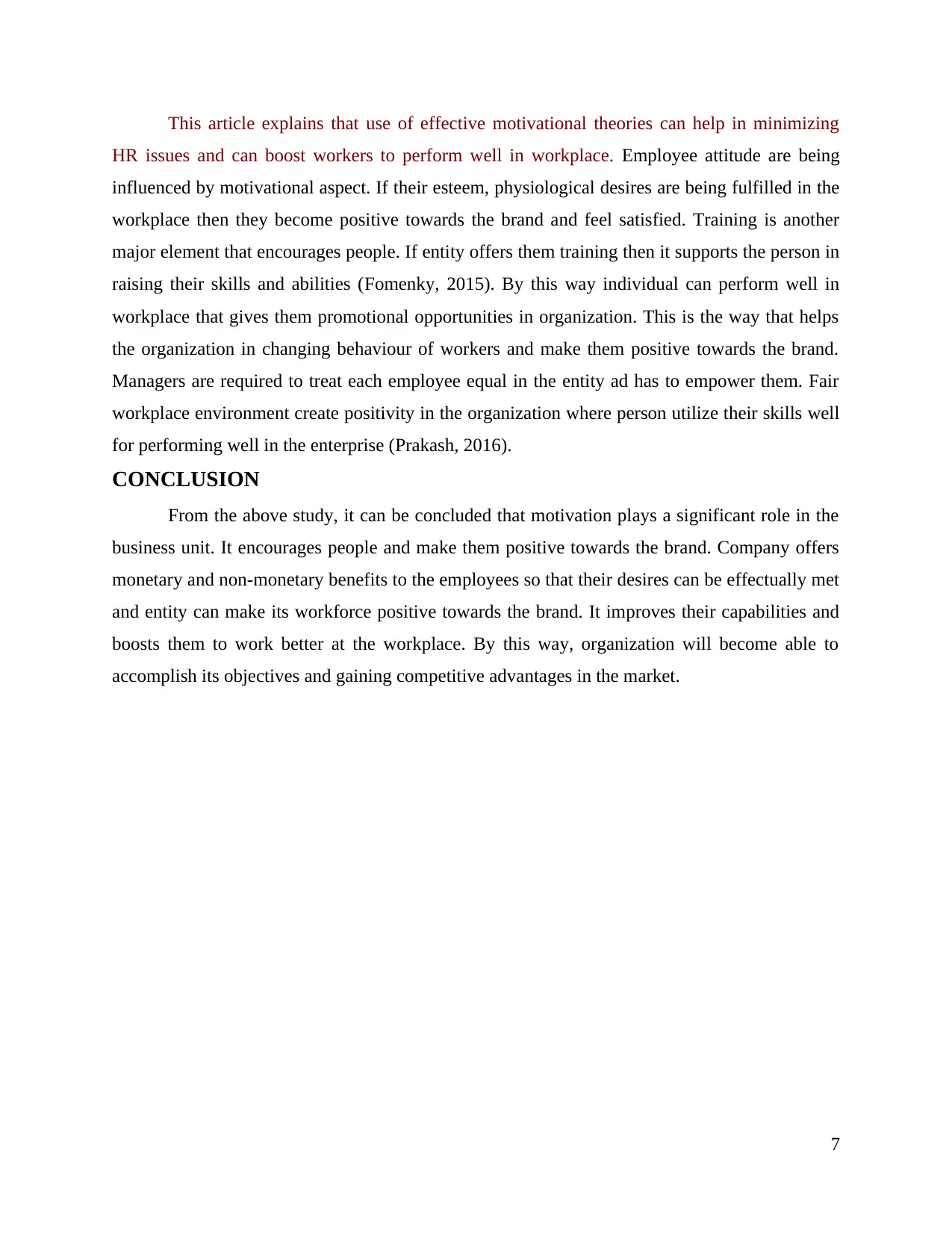
This article explains that use of effective motivational theories can help in minimizing
HR issues and can boost workers to perform well in workplace. Employee attitude are being
influenced by motivational aspect. If their esteem, physiological desires are being fulfilled in the
workplace then they become positive towards the brand and feel satisfied. Training is another
major element that encourages people. If entity offers them training then it supports the person in
raising their skills and abilities (Fomenky, 2015). By this way individual can perform well in
workplace that gives them promotional opportunities in organization. This is the way that helps
the organization in changing behaviour of workers and make them positive towards the brand.
Managers are required to treat each employee equal in the entity ad has to empower them. Fair
workplace environment create positivity in the organization where person utilize their skills well
for performing well in the enterprise (Prakash, 2016).
CONCLUSION
From the above study, it can be concluded that motivation plays a significant role in the
business unit. It encourages people and make them positive towards the brand. Company offers
monetary and non-monetary benefits to the employees so that their desires can be effectually met
and entity can make its workforce positive towards the brand. It improves their capabilities and
boosts them to work better at the workplace. By this way, organization will become able to
accomplish its objectives and gaining competitive advantages in the market.
7
HR issues and can boost workers to perform well in workplace. Employee attitude are being
influenced by motivational aspect. If their esteem, physiological desires are being fulfilled in the
workplace then they become positive towards the brand and feel satisfied. Training is another
major element that encourages people. If entity offers them training then it supports the person in
raising their skills and abilities (Fomenky, 2015). By this way individual can perform well in
workplace that gives them promotional opportunities in organization. This is the way that helps
the organization in changing behaviour of workers and make them positive towards the brand.
Managers are required to treat each employee equal in the entity ad has to empower them. Fair
workplace environment create positivity in the organization where person utilize their skills well
for performing well in the enterprise (Prakash, 2016).
CONCLUSION
From the above study, it can be concluded that motivation plays a significant role in the
business unit. It encourages people and make them positive towards the brand. Company offers
monetary and non-monetary benefits to the employees so that their desires can be effectually met
and entity can make its workforce positive towards the brand. It improves their capabilities and
boosts them to work better at the workplace. By this way, organization will become able to
accomplish its objectives and gaining competitive advantages in the market.
7
⊘ This is a preview!⊘
Do you want full access?
Subscribe today to unlock all pages.

Trusted by 1+ million students worldwide
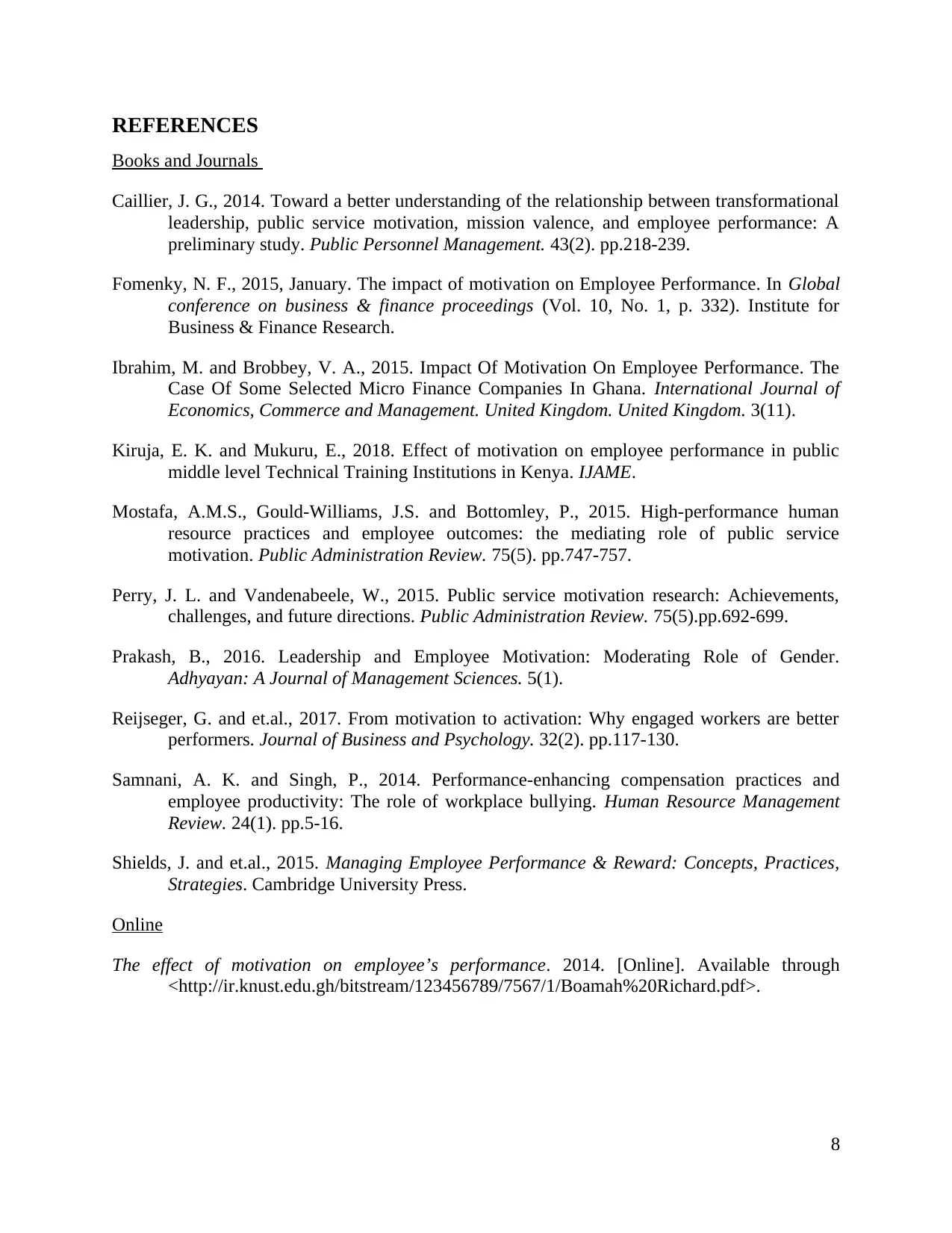
REFERENCES
Books and Journals
Caillier, J. G., 2014. Toward a better understanding of the relationship between transformational
leadership, public service motivation, mission valence, and employee performance: A
preliminary study. Public Personnel Management. 43(2). pp.218-239.
Fomenky, N. F., 2015, January. The impact of motivation on Employee Performance. In Global
conference on business & finance proceedings (Vol. 10, No. 1, p. 332). Institute for
Business & Finance Research.
Ibrahim, M. and Brobbey, V. A., 2015. Impact Of Motivation On Employee Performance. The
Case Of Some Selected Micro Finance Companies In Ghana. International Journal of
Economics, Commerce and Management. United Kingdom. United Kingdom. 3(11).
Kiruja, E. K. and Mukuru, E., 2018. Effect of motivation on employee performance in public
middle level Technical Training Institutions in Kenya. IJAME.
Mostafa, A.M.S., Gould‐Williams, J.S. and Bottomley, P., 2015. High‐performance human
resource practices and employee outcomes: the mediating role of public service
motivation. Public Administration Review. 75(5). pp.747-757.
Perry, J. L. and Vandenabeele, W., 2015. Public service motivation research: Achievements,
challenges, and future directions. Public Administration Review. 75(5).pp.692-699.
Prakash, B., 2016. Leadership and Employee Motivation: Moderating Role of Gender.
Adhyayan: A Journal of Management Sciences. 5(1).
Reijseger, G. and et.al., 2017. From motivation to activation: Why engaged workers are better
performers. Journal of Business and Psychology. 32(2). pp.117-130.
Samnani, A. K. and Singh, P., 2014. Performance-enhancing compensation practices and
employee productivity: The role of workplace bullying. Human Resource Management
Review. 24(1). pp.5-16.
Shields, J. and et.al., 2015. Managing Employee Performance & Reward: Concepts, Practices,
Strategies. Cambridge University Press.
Online
The effect of motivation on employee’s performance. 2014. [Online]. Available through
<http://ir.knust.edu.gh/bitstream/123456789/7567/1/Boamah%20Richard.pdf>.
8
Books and Journals
Caillier, J. G., 2014. Toward a better understanding of the relationship between transformational
leadership, public service motivation, mission valence, and employee performance: A
preliminary study. Public Personnel Management. 43(2). pp.218-239.
Fomenky, N. F., 2015, January. The impact of motivation on Employee Performance. In Global
conference on business & finance proceedings (Vol. 10, No. 1, p. 332). Institute for
Business & Finance Research.
Ibrahim, M. and Brobbey, V. A., 2015. Impact Of Motivation On Employee Performance. The
Case Of Some Selected Micro Finance Companies In Ghana. International Journal of
Economics, Commerce and Management. United Kingdom. United Kingdom. 3(11).
Kiruja, E. K. and Mukuru, E., 2018. Effect of motivation on employee performance in public
middle level Technical Training Institutions in Kenya. IJAME.
Mostafa, A.M.S., Gould‐Williams, J.S. and Bottomley, P., 2015. High‐performance human
resource practices and employee outcomes: the mediating role of public service
motivation. Public Administration Review. 75(5). pp.747-757.
Perry, J. L. and Vandenabeele, W., 2015. Public service motivation research: Achievements,
challenges, and future directions. Public Administration Review. 75(5).pp.692-699.
Prakash, B., 2016. Leadership and Employee Motivation: Moderating Role of Gender.
Adhyayan: A Journal of Management Sciences. 5(1).
Reijseger, G. and et.al., 2017. From motivation to activation: Why engaged workers are better
performers. Journal of Business and Psychology. 32(2). pp.117-130.
Samnani, A. K. and Singh, P., 2014. Performance-enhancing compensation practices and
employee productivity: The role of workplace bullying. Human Resource Management
Review. 24(1). pp.5-16.
Shields, J. and et.al., 2015. Managing Employee Performance & Reward: Concepts, Practices,
Strategies. Cambridge University Press.
Online
The effect of motivation on employee’s performance. 2014. [Online]. Available through
<http://ir.knust.edu.gh/bitstream/123456789/7567/1/Boamah%20Richard.pdf>.
8
1 out of 10
Related Documents
Your All-in-One AI-Powered Toolkit for Academic Success.
+13062052269
info@desklib.com
Available 24*7 on WhatsApp / Email
![[object Object]](/_next/static/media/star-bottom.7253800d.svg)
Unlock your academic potential
Copyright © 2020–2025 A2Z Services. All Rights Reserved. Developed and managed by ZUCOL.





